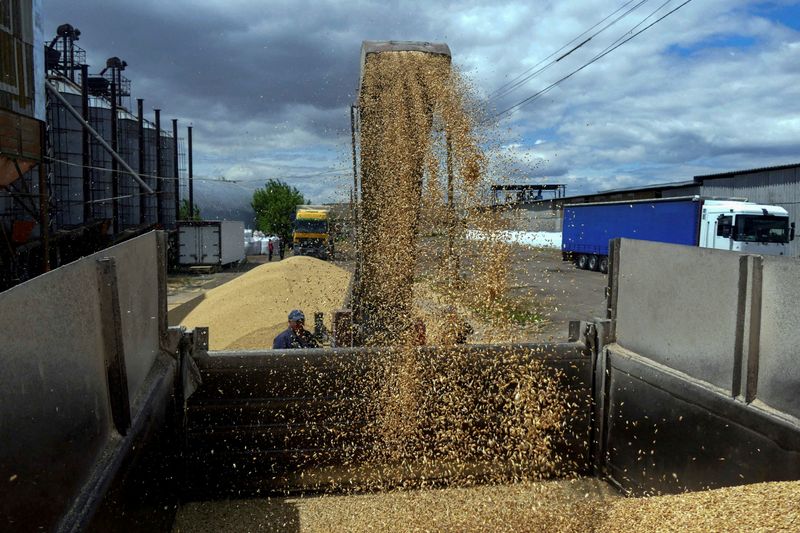Commodities
Exclusive-Ukraine plans same 2024 sowing area as 2023, has concerns on wheat quality -minister


© Reuters. FILE PHOTO: A worker loads a truck with grain at a terminal during barley harvesting in Odesa region, as Russia’s attack on Ukraine continues, Ukraine June 23, 2022. REUTERS/Igor Tkachenko/File Photo
2/3
By Pavel Polityuk
KYIV (Reuters) – Ukraine expects its 2024 spring sowing area to be the same as last year, though it could see a slight decrease in the worst case scenario, Agriculture Minister Mykola Solsky told Reuters on Friday.
Ukraine is a major global grain and oilseeds producer but its harvests have decreased since Russia invaded and occupied significant swathes of territory. The war, now in its 24th month and with no end in sight, has driven up global grain prices and disrupted supplies, especially to poorer countries.
“I don’t expect any drastic changes in terms of sowing area. If the sowing area is smaller, it will be a very insignificant decrease,” Solsky said in an interview, providing the first official outlook for the 2024 sowing season.
Ukrainian farmers sowed a total of 12.75 million hectares of spring crops for the 2023 harvest, including 5.7 million hectares of various grains.
The acreage included 4 million hectares of corn, 5.3 million hectares of sunflower and 1.78 million hectares of soy beans.
Solsky said farmers had sown a smaller area of winter wheat last autumn due to poor weather and this could force them to increase the area sown to spring wheat. Ukraine sowed 280,000 hectares of spring wheat last year.
Ukraine sowed 4.2 million hectares of winter wheat for the 2024 harvest versus around 4.4 million hectares a year earlier.
“There will definitely be no increase in the overall sowing area. I admit its reduction, and the question immediately arises what to sow then? We have three options only – sunflower, soy and corn,” the minister said.
He said farmers would try to increase the area sown to soy, but a lack of high quality soy seeds could prove a serious obstacle. He also noted that relatively low sunflower seed prices and a mandatory crop rotation would prevent a future increase in the area sown to sunflowers.
Ukraine harvested around 28.7 million metric tons of corn in the 2023 harvest, threshing almost 91% of the sown area. Some corn still remains unharvested in the fields.
QUALITY CONCERNS
Solsky said farmers’ shortage of funds caused by the war and difficulties with exports had forced them to save money and use lower quality wheat seed.
He said winter wheat had survived the winter so far without serious damage but the quality of the future harvest was unclear.
“There is one problem – it seems to me that our seeds are getting worse and worse,” Solsky said.
“It seems to me that farmers are saving money on winter wheat seeds… and (this is) one of the reasons for the worse quality of wheat.”
Ukrainian farmers’ incomes have declined significantly due to difficulties in exporting the 2022 and 2023 harvests resulting from limited shipping capacity from seaports and the expensive logistics of using land corridors.
It is crucial for Ukraine to preserve its farming industry. Before Russia’s full-scale invasion, Ukraine was the world’s fourth-largest grain supplier and in value terms the commodity accounted for half of all Ukrainian exports.
Ukraine harvested almost 110 million metric tons of grains and oilseeds before the war, but in 2023 the combined harvest had fallen to just over 81 million tons because much of the territory was occupied or mined.
Commodities
Oil prices rise; U.S. crude inventories plunge, Russia-Ukraine truce eyed
Commodities
India’s Reliance to stop buying Venezuelan oil over US tariffs, sources say
Commodities
Oil prices climb on Venezuela supply worries

 Forex3 years ago
Forex3 years agoForex Today: the dollar is gaining strength amid gloomy sentiment at the start of the Fed’s week

 Forex3 years ago
Forex3 years agoUnbiased review of Pocket Option broker

 Forex3 years ago
Forex3 years agoDollar to pound sterling exchange rate today: Pound plummeted to its lowest since 1985

 Forex3 years ago
Forex3 years agoHow is the Australian dollar doing today?

 Cryptocurrency3 years ago
Cryptocurrency3 years agoWhat happened in the crypto market – current events today

 World3 years ago
World3 years agoWhy are modern video games an art form?

 Commodities3 years ago
Commodities3 years agoCopper continues to fall in price on expectations of lower demand in China

 Economy3 years ago
Economy3 years agoCrude oil tankers double in price due to EU anti-Russian sanctions























